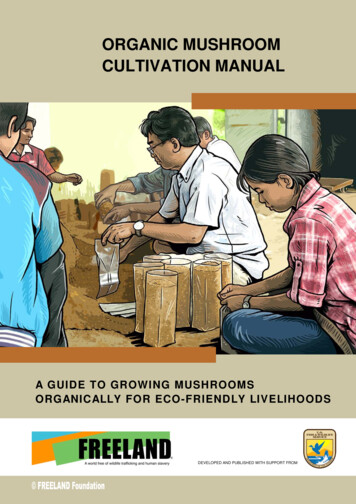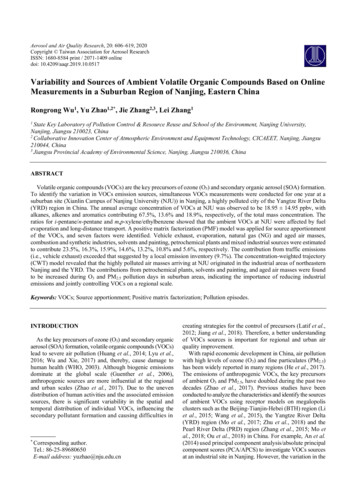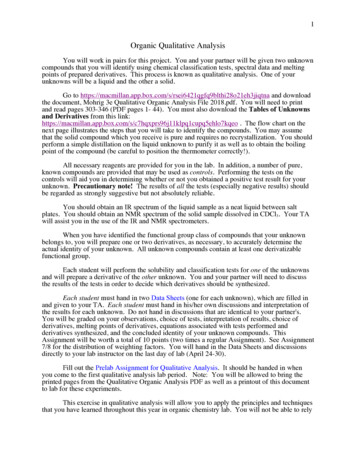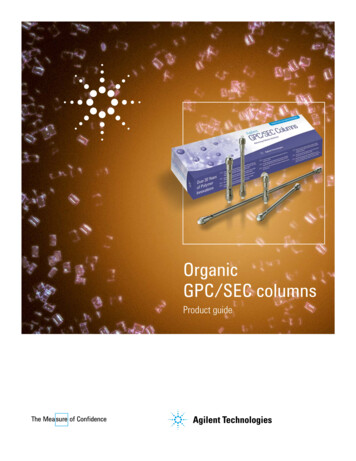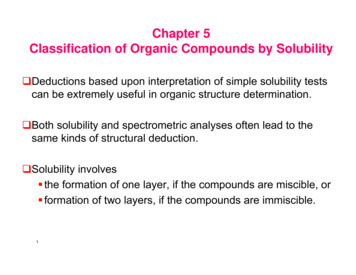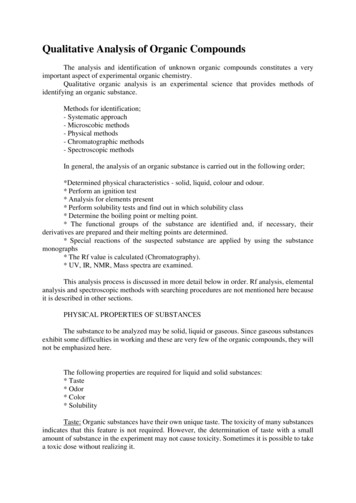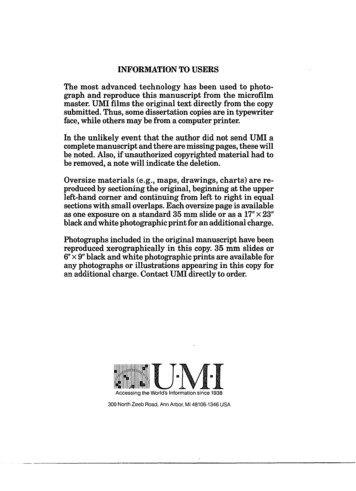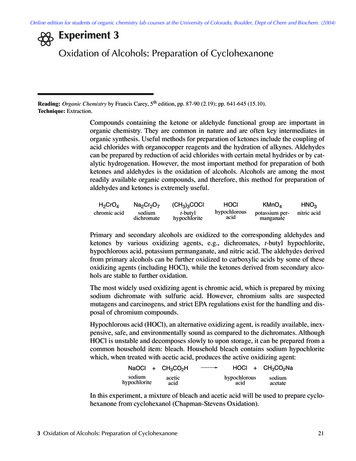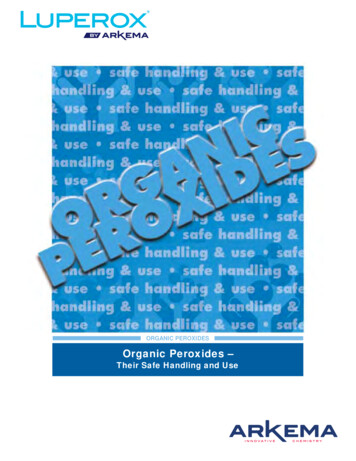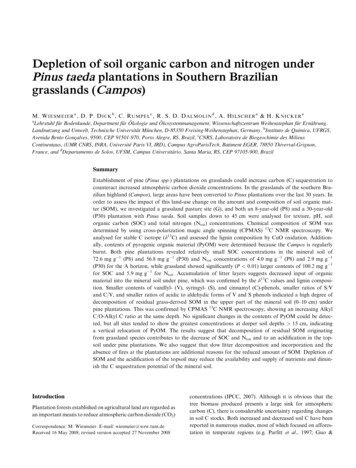
Transcription
ORGANIC LABORATORY TECHNIQUES 3 3.1FILTRATION METHODSThere are several filtration methods : simple or gravity, hot and vacuum filtrations. The selection of theappropriate method is typically dictated by the nature of the experimental situation. The answers to eachthese questions help dictate what type of set up is required.1. Are you collecting the solid or the filtrate (solution) ? If you are collecting the solid, vacuum methodsare likely best as they are faster. If you are collecting the filtrate (solution), gravity filtration methodsare often preferred.2. How much solution is there to filter ? If you have a large volume to filter, gravity filtration is probablythe better choice. Vacuum filtration is fast but if you need to empty the flask part way through youhave to release the pressure and remove the funnel to do this which increases the risk of spills andslows things down.3. How much solid is being collected ? If only a small amount is being collected, a vacuum filtrationusing the Hirsch funnel is preferred.4. How fine is the solid ? If it’s a fine solid, regular filtration might be very slow, so use vacuum filtration.5. Will unwanted crystallisation occur in the filter funnel ? If yes, use hot filtration.a. The filter paperFirst, make sure you use the appropriate size filter paper. This is most important for vacuumfiltration where the paper should smaller in diameter than the base of Buchner or Hirsch funnel (but itmust cover all the holes) and should sit flat on the bottom of the funnel with no creases or folds.Second, folding the filter paper. There are two ways to fold filter papers, the "conventional"method and "fluted".Here are two videos showing how to fold filter papers.(version 1, version 2)
ORGANIC LABORATORY TECHNIQUES 33.2The steps to flute the filter paper are shown. First, foldin half; open and fold in half at 90 to the first fold,subsequently align adjacent folds and make new foldsbisecting the previous folds until a fan-like arrangementis obtained. Pleat into a fan by folding each segment like fashion. When opened out the completefan-like fluted paper results.Fluting the filter paper maximises the rate at which theliquid may flow through the filter paper by increasing thesurface area and by allowing air to enter the flask alongits sides to permit rapid pressure equalisation.b. Gravity or simple filtrationThis is the most common method of filtration and is used to remove an insoluble solid materialfrom a solution. The solid could be the required product or an impurity or an additive such as a dryingagent. A filter paper is folded (conventional or fluted) and placed in a filter funnel which is then placed inthe neck of an Erlenmeyer flask or supported in a clamp or ring stand. The solution to be filtered is thenslowly and carefully poured into the funnel taking care not to fill the funnel above the edge of the filterpaper. Here are two videos showing this filtration method (version 1, version 2)Gravity filtration with a fluted filter paper
ORGANIC LABORATORY TECHNIQUES 33.3c. Hot filtrationNever heat organic solvents with a Bunsen burner. Use a hot plate or a hot waterbath on a hot plate.Sometimes during a gravity filtration, crystals can start to grow in the filter funnel and may block thefunnel, stopping filtration. This problem can be avoided by using a hot filtration where the whole filtrationapparatus is heated in order to prevent the solution from cooling significantly.The hot filtration process is best carried out using a fluted filterpaper and a stemless filter funnel. Support the stemless filterfunnel on an iron ring clamp if it is at all insecure (see thelower picture). If pressure builds up in the flask due to thepresence of hot vapours, the filtering action will slow down oreven stop. The use of the fluted paper reduces this problem.The hot solution should be filtered quickly through the flutedpaper in a stemless filter funnel into an Erlenmeyer flask.Alternatively, a small piece of wire or paper may be insertedbetween funnel and Erlenmeyer to prevent formation of a sealand subsequent pressure build-up. If crystals start to form inthe paper or in the filter funnel, then the Erlenmeyer containinga few drops of pure solvent with the funnel and paper in placeshould be heated on a steam bath (or a hot plate) and theentire filtration procedure carried out on the steam bath. Hotsolvent may be added to remove any crystals appearing in thefilter paper.Do not use metal tongs or a test-tube holder to hold the hotErlenmeyer flask while pouring the liquid since it is too easy todrop the flask.A better convenient simple holder may befashioned from a piece of paper towel folded into a strip andpinched around the neck of the flask.Here is a video showing the hot filtration method.
ORGANIC LABORATORY TECHNIQUES 33.4d. Vacuum filtrationIn a vacuum filtration, the solution to be filtered isdrawn through the filter paper by applying a vacuumto a filter flask with a side arm adaptor (also knownas a Buchner flask). Vacuum filtration is typically afast and efficient way of filtering.The crystals are collected by swirling the mixture ofthe solid and liquid and then pouring quickly it intothe filtration apparatus. This typically comprises aBüchner funnel fitted with the appropriate size filterpaper; a clamped filter flask with conical filteradapter, and a vacuum applied to the side arm ofthe filter flask (see left).Vacuum filtration with a Buchner funnelIf smaller quantities are to be filtered the Hirschfunnel (see left and below) and a small filter papershould be used instead. If needed, the filter flaskcan be replaced by a test tube with side arm. Again,the tube should be clamped and the vacuum appliedat the side arm using the thick walled vacuumtubing.When using vacuum filtration, it is very importantthat the correct size of filter paper be used. The filterpaper should be flat (i.e. not folded up at the edges)and should cover all the holes in the base of thefunnel. It is also important that the apparatus beclamped since it is very easily tipped over usuallyresulting in loss of the sample.Vacuum filtration with a Hirsch funnel
ORGANIC LABORATORY TECHNIQUES 33.5To filter the crystals, assemble the apparatus, ensuring that the funnel is sealed into the flask; turn theaspirator tap full on; moisten the filter paper with a little cold solvent to adhere the paper to the funnel, toprevent crystals from creeping under the paper and through the filter. The mother liquor containing thecrystals may now be filtered. The crystals should then be rinsed with a small portion of cold solvent.Allow the crystals to remain exposed to the vacuum for a few minutes in order to dry them.DISCONNECT THE TUBING BEFORE TURNING OFF THE ASPIRATOR TAP. Thick-walled pressuretube is used throughout the apparatus. A trap is used in conjunction with the water aspirator. If the waterpressure in the laboratory line drops suddenly, the pressure in the filter flask may become less than thatin the water aspirator. This would cause water to be drawn from the aspirator stream into the filter flaskand would contaminate the filtrate. The trap stops this reverse flow. A similar reverse flow would occur ifthe water flow at the aspirator were stopped before disconnecting the tubing to the aspirator side-arm oropening the valve on the top of the water trap.
entire filtration procedure carried out on the steam bath. Hot solvent may be added to remove any crystals appearing in the filter paper. Do not use metal tongs or a test-tube holder to hold the hot Erlenmeyer flask while pouring the liquid since it is too easy to drop the flask. A better convenient simple holder may be fashioned from a piece of paper towel folded into a strip and pinched .
